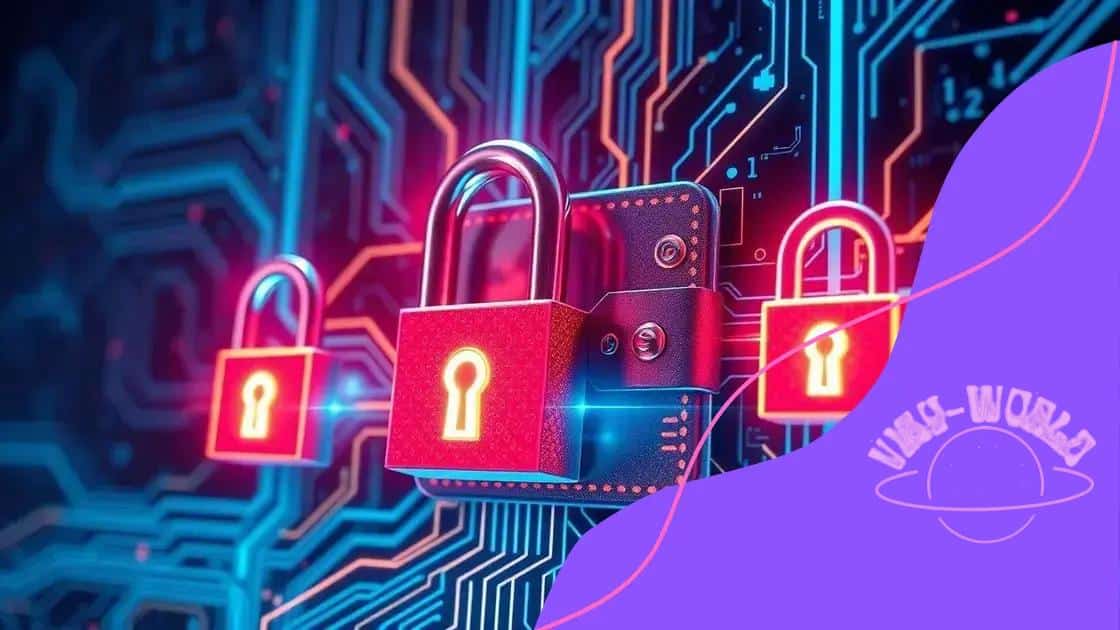Digital wallet security enhancements: protecting your funds

Enhancing digital wallet security involves using strong passwords, enabling two-factor authentication, regularly updating your app, and actively monitoring transactions for suspicious activity.
Digital wallet security enhancements are crucial in today’s digital age, where our finances are largely handled online. Have you considered how secure your digital wallet really is? Let’s explore key strategies that can keep your funds protected.
Understanding digital wallet vulnerabilities
Understanding digital wallet vulnerabilities is essential for anyone who uses these platforms for transactions. Many people are unaware of the specific risks involved, which can make their funds and personal data insecure. Digital wallets have gained popularity for their convenience, but with this comes certain vulnerabilities that need to be addressed.
Common Vulnerabilities
One of the most prevalent issues is the lack of adequate security measures. Here are a few common vulnerabilities:
- Weak passwords that can be easily guessed
- Phishing attacks that trick users into revealing personal information
- Unsecured networks that expose wallet access to hackers
- Outdated software that lacks the latest security patches
Many users may not realize how these vulnerabilities can lead to potential theft or loss of funds. For instance, phishing attacks can often seem legitimate, making it easy for a user to fall victim to such tricks. Furthermore, the importance of using strong passwords cannot be overstated. A strong password acts as the first line of defense against unauthorized access.
Protecting Your Digital Wallet
To effectively protect your digital wallet, it is crucial to recognize and understand these vulnerabilities. By staying informed, users can take action to safeguard their information. Regularly updating your wallet and ensuring you are using two-factor authentication can significantly reduce the risk of unauthorized access.
Additionally, avoid accessing your digital wallet over public Wi-Fi. When you connect to unsecured networks, you expose your wallet to potential attacks. Always use a secure, private connection when managing your funds or personal information online.
Recognizing these vulnerabilities helps in making more informed decisions to enhance wallet security. Keeping your software up-to-date, utilizing strong passwords, and being aware of phishing tactics will put you in a much more secure position. By taking these simple yet effective steps, you can protect your financial assets and enjoy the convenience of your digital wallet without unnecessary risks.
Best practices for securing your digital wallet
Best practices for securing your digital wallet can significantly reduce the risk of unauthorized access and theft. As users increasingly rely on digital wallets for transactions, it is essential to implement these practices to ensure the safety of your funds.
Use Strong Passwords
Creating strong, unique passwords is the first step in protecting your wallet. Avoid using easily guessed passwords such as birthdays or common phrases. Instead, consider these tips:
- Combine letters, numbers, and special characters.
- Avoid using the same password across multiple platforms.
- Change your passwords regularly.
Strong passwords act as a barrier against unauthorized access. They help ensure that even if someone attempts to breach your account, they will not succeed easily.
Enable Two-Factor Authentication
Another essential practice is enabling two-factor authentication (2FA). This adds an additional layer of security by requiring a second form of verification, often a text message or an app code, along with your password.
2FA can significantly reduce the likelihood of unauthorized access, making it much harder for someone to hijack your account. Whenever possible, use 2FA as an added safety measure.
Keep in mind that cybercriminals often use tactics like phishing to gain access to wallets. Staying informed about scams can help you avoid falling victim. Be cautious of unexpected messages or emails requesting your information.
Regular Updates
Keeping your wallet app updated is crucial for using the latest security features. Developers regularly release updates that address vulnerabilities and improve overall security.
Install updates as soon as they are available to make sure you have the best protection possible. Ignoring updates can leave your wallet exposed to potential threats.
To sum up, implementing best practices such as using strong passwords, enabling two-factor authentication, and regularly updating your wallet app are key to securing your digital wallet. Adopting these habits can help you enjoy the convenience of digital wallets while not compromising your financial safety.
The role of encryption in wallet safety

The role of encryption in wallet safety is crucial for protecting your digital assets. When transactions and personal information are stored in a digital wallet, it is essential to ensure they are secure from unauthorized access.
What is Encryption?
Encryption is a process that transforms your data into a code to prevent unauthorized access. It makes sure that even if someone attempts to obtain your information, they will not be able to read it without the correct decryption key.
For digital wallets, encryption protects sensitive data, like payment information and personal details, from being stolen. Without encryption, hackers could easily access and misuse this data.
Types of Encryption
There are several types of encryption used to secure digital wallets:
- Symmetric encryption: The same key is used for both encrypting and decrypting the information.
- Asymmetric encryption: This method uses a pair of keys; one public and one private. The public key encrypts the data while the private key decrypts it.
- End-to-end encryption: Only the sender and recipient can read the messages. This means that even the service provider cannot access the data.
Utilizing the right type of encryption can greatly enhance your security. Always choose wallets that implement robust encryption methods to safeguard your information.
The Importance of Regular Updates
Regular updates to both your digital wallet app and its encryption protocols are essential. As technology evolves, so do security threats. Therefore, software developers frequently release updates to address vulnerabilities.
Make it a habit to update your wallet as soon as new versions are released. This ensures that your encryption methods are up to date, providing the best possible protection against potential attacks.
In conclusion, understanding the role of encryption in wallet safety can help users make more informed choices. By prioritizing wallets that use strong encryption methods and keeping them updated, users can enjoy a safer experience when managing their digital funds.
Two-factor authentication: why it matters
Two-factor authentication (2FA) is a critical security measure that adds an extra layer of protection to your digital wallet. By requiring two forms of verification, 2FA helps secure your account from unauthorized access.
How Does 2FA Work?
When you enable 2FA, you typically need to provide two different types of information before gaining access to your account. The first is usually something you know, like your password. The second is often something you have, such as a code sent to your phone or generated by an authentication app.
This system works well because even if someone steals your password, they still cannot access your wallet without the second factor. This significantly decreases the chances of unauthorized access.
Benefits of Two-Factor Authentication
Implementing 2FA comes with several advantages, making it a popular choice for securing digital wallets:
- Increased security against hacking attempts.
- Protection from phishing scams that only capture your password.
- Ease of setup through various apps and services.
- Peace of mind knowing your funds are more secure.
Each of these benefits highlights how essential 2FA is in the current digital landscape. Without it, your wallet remains vulnerable to potential attacks.
Common Methods of 2FA
There are several common methods to implement two-factor authentication:
- SMS Codes: A text message sent to your phone containing a verification code.
- Email Verification: A code sent to your email for confirmation.
- Authentication Apps: Apps like Google Authenticator generate temporary codes.
These methods are simple to use and provide a robust layer of security. Understanding how each method works can help you choose the best option for your needs.
Relying solely on a password leaves you at risk, but incorporating two-factor authentication greatly enhances your safety. Make sure to enable 2FA as a part of your strategy to protect your digital wallet from possible threats.
Regular updates and monitoring for security
Regular updates and monitoring for security are vital for keeping your digital wallet safe from threats. Cybersecurity is constantly evolving, and staying updated ensures that your wallet has the latest protections against new vulnerabilities.
Importance of Regular Updates
When developers release updates, they often include important security patches. These patches address known vulnerabilities that hackers may exploit. If you neglect to update your wallet app, you leave it exposed to potential attacks.
Consider these points regarding updates:
- Updates often fix bugs that might create security loopholes.
- New features may enhance your wallet’s functionality and security.
- Failing to update can lead to losing access to your funds.
By keeping your wallet app up-to-date, you significantly reduce the risk of unauthorized access. Make it a habit to check for updates regularly and install them as soon as they become available.
Monitoring Your Wallet Activity
Along with updates, actively monitoring your wallet’s activity is essential. Regularly reviewing transactions can help you detect any suspicious activity early. If you notice transactions you did not make, it’s crucial to take action immediately.
Here are some monitoring tips:
- Set up alerts for transactions over a certain amount.
- Regularly check your transaction history for any unknown entries.
- Use security features that notify you of changes to your account.
Being proactive about monitoring your wallet can prevent potential security breaches. The sooner you catch a problem, the easier it will be to resolve it. Remember, taking these precautionary measures protects not just your wallet but also your financial freedom.
Encryption, regular updates, and two-factor authentication are key elements to protect your funds and personal data. Additionally, monitoring your account activity can help you spot any suspicious actions quickly. By following these best practices, you can enjoy the convenience of digital wallets while keeping your information safe and secure.
FAQ – Frequently Asked Questions About Digital Wallet Security
What is two-factor authentication and why is it important?
Two-factor authentication (2FA) adds an extra layer of security by requiring a second form of verification, making it much harder for unauthorized users to access your wallet.
How often should I update my digital wallet app?
You should update your digital wallet app as soon as new versions are released. Regular updates ensure that you have the latest security features and fixes.
What steps can I take to create a strong password?
To create a strong password, combine letters, numbers, and symbols, avoid common phrases, and do not use the same password across multiple platforms.
How can I monitor my wallet for suspicious activity?
You can monitor your wallet by regularly checking your transaction history and setting up alerts for large or unusual transactions.





